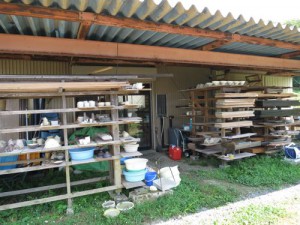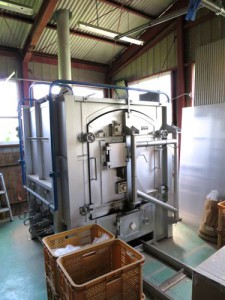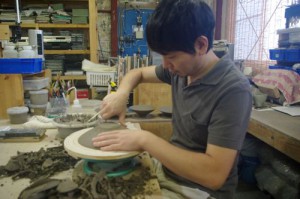Artist Interview with Kazunori Koutsuka, Mokkobo Gen(part2 English)
2017.12.28
I conducted an interview with Kazunori Koutsuka, who has been making wooden kitchen utensils and furniture at a workshop in Shioyamachi, Tochigi prefecture. I visited his workshop and talked with him and other three young staffs.
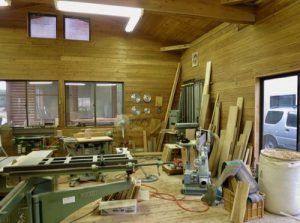

Koutsuka san used to play football when he was in high school, but he decided to become a wood worker after graduation. He started to learn woodworks as a temporary staff first, and worked as a wood worker and devoted himself to improving his skills at three different companies for ten years. He began his own business when he was 30.
Many of the wood workers buying lumber but Koutsuka san goes to Aizu area to see the logs directly and buying logs and he gives directions to a lumbermill. Koutsuka san said that he does those direction works to use up the materials efficiently. “Time is money” he also said. “It is important to think about “efficiency” and we can take more time to make our products.”
Craftwork is not an easy job. They learn much from experience. For example, Koutsuka san learned how to see a tree from senior people in forest industry with a lot of experience and knowledge.
However, until producing a wooden product, there so many people, time and process are needed. Roughly speaking, cutting down trees from the mountain first, and strip the bark off from a log, and then timber-conversion allocation is efficiently executed at a lumbermill and dry them until deliver. Even dry method is different in terms of kind, such as artificially drying and natural drying lumber. So, before a wood worker make his/ her works, many process passed as above.
In the case of woodwork, you cannot make the material (tree) itself. Or you cannot always find wood of his liking. That means, you need to keep a certain quantity of wood. So Koutsuka san works efficiently according tot his operation plan.
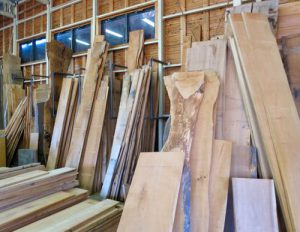
They work start from 7:00 a.m. to 4:30 p.m. Koutsuka san said, “especially, you should concentrate and work hard in the morning time”. Is it about “The early bird catches the worm”? After 4:30, workshop will be open for other young staffs. They can study or make something that they want to.
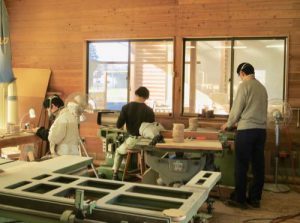
Koutsuka san showed me how to make a flower petal shape coaster.
Cut roughly with a jig saw machine first.
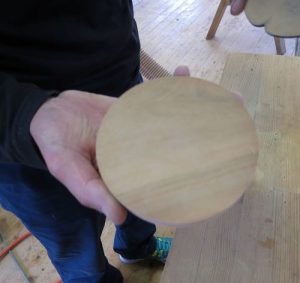
It will be removed the bottom and side roughly.
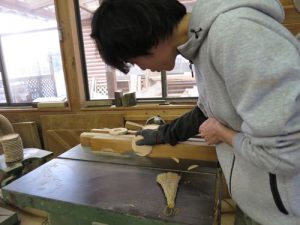
Then, it will be polished using the machine.
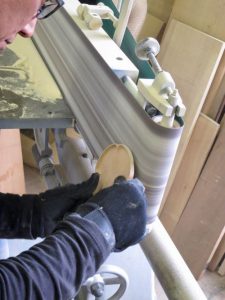
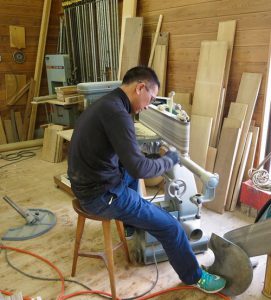
Before polishing (left) and after polishing (right)
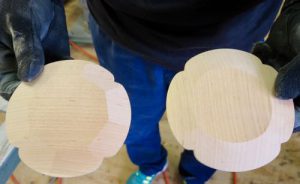
Carve into the surface of the edge with u-shaped carving knife at a steady pace.
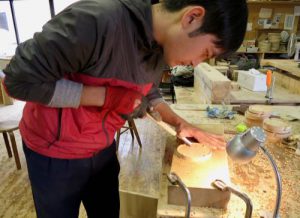
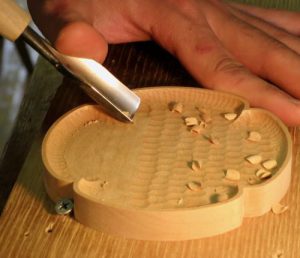
And it will be polished by hand at the finishing process.
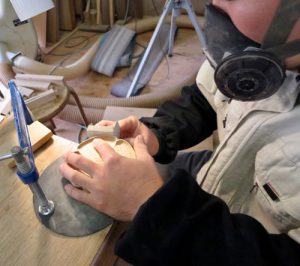
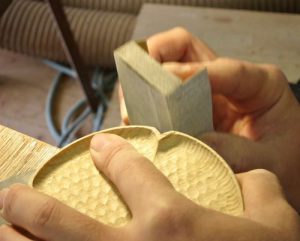
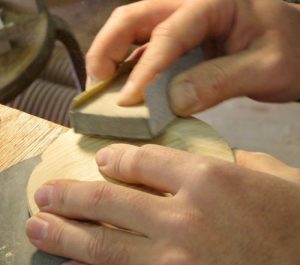
Becomes a wood product, there are many processes should be done with many people’s thoughts and feelings as mentioned earlier. I think that there is something fascinating about handmade products. When you touch it or use it, it’ll gives you some impression and make your life more comfortable. They put their heart into making the items. I hope you could find a special one for you from Mokkobo Gen.
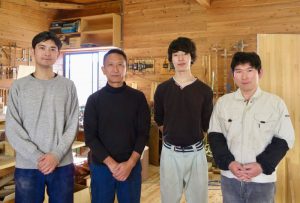
Member of Mokkobo Gen
From the left; Umito Kuramochi, Kazunori Koutsuka (Representative), Shuhei Kuroko and Satoshi Sekiya
Artist Interview, Ian Hayden(part2 English)
2016.11.02
I conducted an interview with Ian Hayden, who has been living in Japan for over 30 years and is currently working as a wood turning artist. I visited his workshop in Nikko, Tochigi.
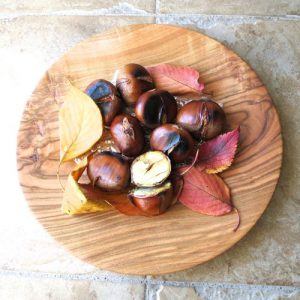
○Please tell me what made you decide to become a professional wood turning artist?
→I started by making small items out of wood works as my hobby, and then bought a wood turning lathe and starting being a bit more creative. After seeing my work, my friends asked me to join their tent at the Mashiko Pottery Fair a few years ago, which got me started to think about becoming a professional.
○What was the reaction to your work at Pottery Fair?
→It was really good opportunity to hear impressions from customers directly, and I think this was one of the turning points that made me decide to be a professional. You could find small boxes or other woodworks at the Pottery Fair about six years ago, but wood turning was rare. People picked up my work, feeling the surfaces with their hands, and touched said, “it feels really good”. From the various comments and conversations I had, I realized then that people love both the touch of wood and its natural warmth.
In fact I had an unforgettable experience at the Pottery Fair. A lady who was the first purchaser of my work said, “This is my treasure,” and she was holding a wooden salad bowl I had made. I was so moved to know that my work could give someone so much happiness. This was an immeasurable sense of accomplishment. There are things that you can’t buy with money.
○Why did you want to work as a woodturner in Japan?
→Japan is my home. I have been living in Japan over 30 years with my wife.
Many foreigners – often on transfer through their companies – live in Japan for just four or five years, but they soon return home when their contract is over, or sometimes for the education of their children. But we both love this country and both have been working in Japan. We feel there is no reason to leave. Living in Japan is something natural for us.
Also, I think there is market potential for wood crafts in Japan. Although pottery is more popular, wooden products are unique and there are different business opportunities from those for pottery. There is also lots of good quality wood in Japan.
○Please tell me about your workshops. You have workshops in Nikko and Tokyo. What do you do in each place?
→I purchase most wood from either Yamagata or Tochigi. I keep this wood in Nikko and cut them down to appropriate sizes and take them back to Tokyo. I imagine what I should make from the piece of wood before I cut each piece.
My wife is working in Tokyo on the weekdays, so I also work at my workshop in Tokyo. And we spend time together in Nikko on the weekend.
○Can you explain the key features of your work?
→I try to make pieces that are as simple and natural as possible. I also want to show the beautiful wood grain of each piece. I think these are the key features of my work.
I think my duty is to expose the beauty from each block wood and “change” it into a wood turning product that can be used in people’s daily life. Pottery is a little different. I think of potters as “adding” work. They work the clay, making it into a shape, and add some glaze – some sort of design – on the surface by hand. In a way, woodturning is the opposite. I cut and shave the wood, and change it into a plate. I am trying not to take away too much from the natural beauty of the wood, in order to emphasize the beauty of the wood grain, its texture, and its shades of color.
○One of the obvious merits or your work as an artist is that you have both a Japanese sense, and at the same time, that of a foreigner. Actually, your wooden plates go well with Japanese pottery.
→I have been told by a customer that she likes the Japanese sense in my work. Of course, I am not a Japanese and I don’t have a native Japanese sense, but still she found some Japanese sense in my work. I think it can be said that my works are “hybrid” or a unique style.
○You haven’t studied wood turning under anybody but studied by yourself. How did you solve technical problems that you faced?
→I read many of the magazines about wood turning and watch many videos on YouTube. Those are really useful.
○What would you like to try with your work in the future?
→I am interested in simple curving and I also am thinking to make my work with different kinds of wood, mixing them together in one piece. And I always try to minimize waste as much as possible.
Thank you very much, Hayden san!
He will participate in Mashiko Pottery Fair start from November 3(Thur.) to November 7(Mon.).
Mashiko Pottery Fair
<Photos of villa and workshop>
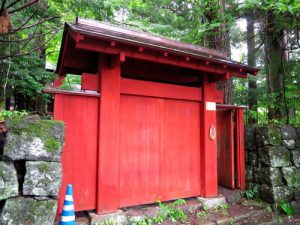
Beautiful red gate of villa, Nikko
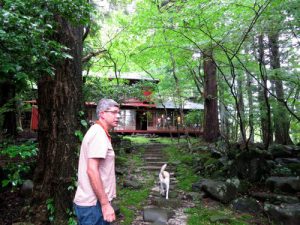
Hayden san and Mick
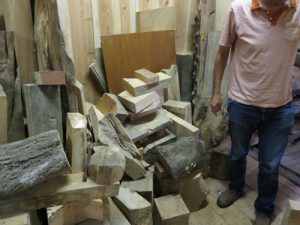
At the workshop
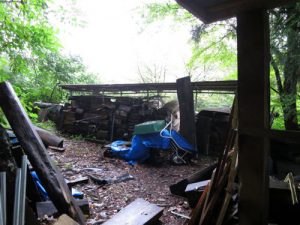
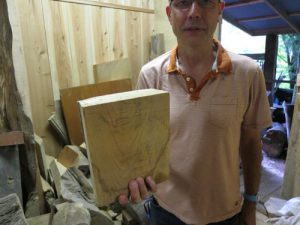
Cut into a small wood block
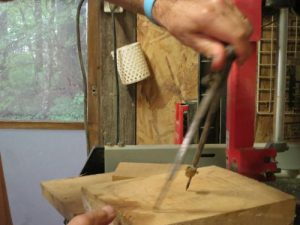
Measure the size and draw a line
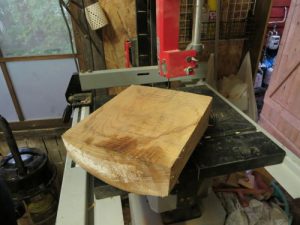
Cut along the line
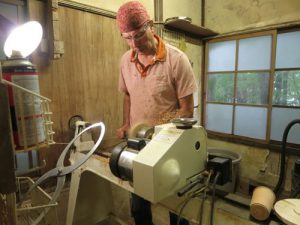
Using wood turning machine
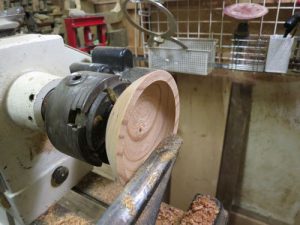
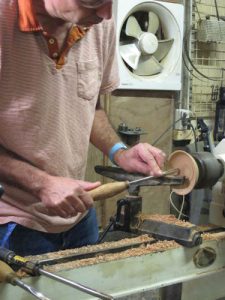
Turning wood on a lathe using a skew and gouge tool

Several tools for wood turning
Ian Hayden Profile
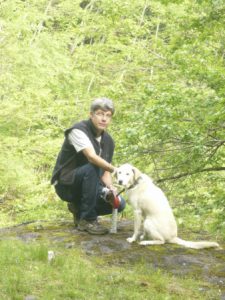
Graduated in Geology at London University, 1982
Studied on a post-graduate research scholarship at Kyushu University, 1986
Started woodturning, 2010
Participating Mashiko Pottery Fair and holding exhibition in Kanuma and Takasaki.
Made special plate for the Nikko Toshogu (UNESCO World Heritage designated Temple and Shrines) 400th Year Shikinen Grand Festival, 2015
作家インタビュー イアン・ヘイデン(パート1 日本語)
2016.11.02
30年以上日本に住み、現在ウッドターニング(木工旋盤)作家として活躍するイアン・ヘイデンさん。
日光にある工房を訪ね、取材しました。

○プロのウッドターニング作家になろうとしたきっかけを教えて下さい
→最初は趣味で小さな作品を作るだけでしたが、その後ウッドターニング用の機械を購入し、よりクリエイティブな作品を作るようになりました。今から数年前に私の作品をみた作家の友人達が益子の陶器市に出てみないかと誘ってくれたのをきっかけに、プロとしてやっていくかどうかを意識しました。
○陶器市に参加してみて、どうでしたか?
直接お客様から色々な感想を聞くことができた良い機会でもあり、またプロとしてやっていこうと決心したターニングポイントにもなりました。
今から6年位前、陶器市では小物や箱の木工作品はありましたが、ウッドターニング製品は殆どなく、珍しかったのです。お客様は皆、作品を手に取り木の感触を味わい、気持ちが良いと言ってくれました。そうした感想を直接聞くことで、人は木の自然のぬくもりが好きなのだとあらためて感じました。
また、益子の陶器市で忘れられない体験をしました。私の作品を最初に買ってくれた女性がこう言ってくれたのです。私の作ったサラダボウルを抱いて「これは私の宝物です」だと。私は、自分が手がけたものによって人が喜んでくれた、そのことに大変感動しました。この達成感は計り知れなく、お金では得られない何ともいえない満足感がありました。
○日本で活動しようと思ったのはなぜですか?
→日本は私のホームです。30年以上夫婦で暮らしています。日本に住む多くの外国人は4〜5年しか住まず、仕事の契約期間や子供の教育等を理由に帰国する人達が多いです。しかし我々は二人とも日本が大好きで、また仕事をもっていたので、この国を離れる理由がありませんでした。私達にとって日本に住むことは自然なことなのです。
また、日本は木工作品について潜在的な市場があると思います。もちろん陶磁器の方が人気はありますが、木はユニークで、陶磁器とはまた違ったビジネスチャンスがあると捉えています。それから日本には素晴らしい木材が沢山ある
○工房について聞かせてください。ヘイデンさんは日光と東京、2箇所に工房を持っていますが、それぞれどのような作業をしているのでしょうか?
→私は使う木材のほとんどを山形と栃木県から仕入れ、日光の工房に保管しています。そしてそれぞれの木材を見てどんなものを作るかイメージし、適当なサイズにカットしたものを東京の工房へ運びます。妻は平日都内で仕事をしているので、私も平日は東京の工房で作業します。そして週末は二人で日光の別荘・工房で過ごしています。
○ヘイデンさんご自身は自分の作品の特徴はどんなところにあると思いますか?
→できるだけシンプルで自然なかたち、そしてそれぞれの木目の美しさを生かしていることが私の作品の特徴だと思います。
私の役目は、それぞれの木片の中の美しさを引き出し、人々の生活に使える物に「変える」ことだと思っています。
陶器とは少し違うかもしれませんね。陶器はどちらかというと何かを「加える」作業です。土を練り、成型し、釉薬をかけるなど、手作業が加わります。一方ウッドターニングは、ある意味ではその反対、といえます。木を切る、削るなどの「引き算」の作業をして食器等に形を変えます。だからこそ私は、木目の美しさ、質感、様々な色合いが際立つよう、あまり手をかけ過ぎないように心がけています。
○ヘイデンさんの良い所は日本的なセンスと外国人としての自由なセンスの両方を持っていることだと思います。実際、ヘイデンさんの作品は日本の器とも大変合わせやすいと思います。
→あるお客様から、私の日本的なセンスが好きだと言われたことがあります。
もちろん私は日本人ではありませんが、それでも私の作る作品の中に、なんらかの日本的なセンスを感じてくれたのだと思います。
私の作品は、「ハイブリッド」でユニークスタイル、とも言えるかもしれませんね。
○ヘイデンさんはどなたにも師事されず独学で技術を習得されたそうですが、技術的な疑問に直面したときにはどのように解決していったのですか?
→ウッドターニングの専門雑誌を沢山読んだり、YouTubeで沢山のビデオを見たりして学びました。
これらの情報は便利とても役に立ちます。
○今後はどんなことにチャレンジしていきたいですか?
→シンプルなカーヴィングに興味があります。
また違う木材を組み合わせたような作品も面白いのではと思っています。
そして作品をつくるうえで、無駄な材を出来るだけ出さないような作品づくりをしていきたいです。
今日は長い時間、ありがとうございました!
ヘイデンさんは11/3(木)~11/7(月)益子秋の陶器市に今年も出展されます!
是非、ご覧下さい
<工房での様子>

日光の工房がある別荘。目をひく赤門

門から家までのアプローチが美しい。愛犬ミックと。

工房の中の様子。沢山の木材が所狭しと置かれている

外にも出番を待つさまざまな木材が

まずは小さなブロックにカット

コンパスで印を付けます

機械でカットしていきます

機械を作動させ、道具を使い削っていきます

荒削りから徐々に細かい作業に


さまざまな種類のターニングツールを使います
*ウッドターニングとは・・・高速で回転させた木材に刃物をあてて削り作品を作る木工のジャンルのひとつです。
ウッドターニングをする上で木材を回転させるための機械のことを木工旋盤といいます。
仕組みが陶芸で使う轆轤(ろくろ)と同じこともあり、木工ろくろという呼ばれることもあります。
イアン・ヘイデン プロフィール

1982年 ロンドン大学で地質学を学ぶ
1986年 奨学金を得、九州大学大学院課程にて研究
2010年 ウッドターニング(木工旋盤)を使用した創作活動を始める
益子陶器市をはじめ、鹿沼や高崎のグループ展・個展に出展。
2015年には日光東照宮400年式年大祭用に木皿を奉納する。
Artist Interview, Toshifumi Tashiro(part2 English)
2014.11.22
I interviewed Toshifumi Tashiro, potter in Mashiko.
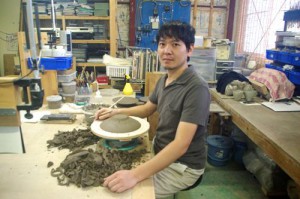
<Profile>
1979 Born in Miyazaki Pref.
2002 Finished Pottery Art Special Course after Graduated from Nara College of Arts, Course of Pottery Art
2002 Started to learn pottery from Seiichi Imanari, Mashiko (Tochigi Pref.)
2007 Became independent and established a pottery studio in Mashiko
*Click here for LOCCA Online Store
-Please tell me what made you start pottery.
When I was a high school student in Osaka, my friend asked me to join pottery club, which was on the verge of breaking up with the shortage of club members. Actually, it was not my own accord but I thought that pottery suits me.
-Please tell me what made you to be a professional potter.
I felt that I wanted to continue pottery when I was in high school and had to decide the course after graduate. So I entered the Nara College of Arts, Course of the Pottery Art. During my work at the college, I became to think how much I myself could do as a professional. So after graduated this junior college, I also took a special course in pottery for more two years. Rather than “job” it’s instead “professional”, I thought at that time.
-Why did you choose to learn pottery in Mashiko after graduated the college?
Before graduating from the special course, I was thinking that I should work on pottery company or became a someone’s disciple, and my college teacher introduced me a potter, Seiichi Imanari in Mashiko. Mr. Imanari used to work in Bizen (where is known as Bizen ware) mainly Yakishime pottery and I was really interested in Yakishime at that time. It required courage to decide to become a disciple. I received advice from people around me and decided to come to Mashiko. (Tashiro-san learned pottery from Mr. Seiichi Imanari for six years.)
-And why did you think to make your own pottery studio in Mashiko?
When I started live in Mashiko, I was thinking about going back to Kansai after I learn for two years. And I begun to think to have my own studio after 4-5 years passed but couldn’t decide the place, I should go back to Kansai or stayed in Mashiko. Meanwhile, a farmer introduced me a vacant house with work place in Mashiko. House was abandoned actually but the work place was really good to be a potter studio, I thought. So I decided to have my own studio there on impulse. And I’m still in this place now.
His studio is just next to his house. He repaired the ceiling, wall and kiln place by himself.
He also designed and made worktables for his wife and himself (his wife is also a potter, name as Hiroko Suzuki) with Rokuro machine! Amazing!
The greatest feature of his work is using a hand potter’s wheel, not electric at the finishing.
He said, “This is the way from Imanari sensei. It takes time however, it remains ununiformed and the warmth of soil.”
-Are you working with no-mindedness while you are making? And do you listen any music while working?
I really want to concentrate when I’m using a wheel but I can talk when I’m work finishing.
I wanted to have a nice audio in my studio and I did. I like to hear something smooth music during my work. I like Jazz, Hiromi Uehara, Keiko Lee, etc. or I listen to the radio.
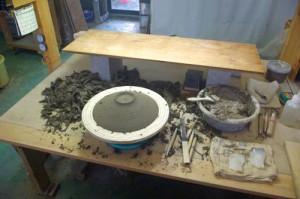
-Now, I’d like to hear about your work again, are you thinking something you’d like to try for the next?
Yes, I have a lot of things that I want to try but it also difficult to make as I imaged. I never know until I make it. I fire once in a month in my studio. Therefore I won’t know a result one month ahead if I want to try something new. Then I modified and test again, and will see the result another one month later. So the testing is very important but I need to focus, which I should test.
-Do you take notes?
I take notes roughly when I thought something really important or idea comes up.
But I definitely take notes every time I tested, recipe of the solid, mud and glaze.
–Do you cook and use your dishes? And do you ever fix your works by them?
I sometimes cook. And I change the specifications, accordingly. The touching or the smoothness will be different with the glaze or firing. Beside the tools are deeply related to the finishing, especially for Yakishime. After bake pottery in kiln, I sometimes polish it with sandpaper.
-Your pottery has a thin and simple shape, could you tell me how could you reach to this kind of shape?
I have liked that simple shape since a long time ago. I think that thin shape is also come from my peculiar habit when I using a wheel. I have tested so many times. Sometimes I could make as I just imaged but failed more than double. On the other hand, I became to think that I should develop an eye, which can notice a different good point even if it was not what I imaged. Those experiences and accidental by-products are extremely useful for making my pottery’s form now.
I have been explored and acquired my styles. And I will continue to explore to make simple but expressive pottery as long as I do this job.
作家インタビュー 田代倫章(パート1 日本語)
2014.11.15
シンプルで洗練された美しいフォルムと質感が印象的な田代さんのうつわ。何を盛ろうか、と毎回想像をかき立てられる。田代倫章さんの益子の工房をたずね、お話をうかがった。

*田代さんの作品はLOCCA Online Storeで購入できます。
— 陶芸を始めたきっかけは何だったのですか?
函館から転校した先の大阪の高校で、部員が減り廃部寸前だった陶芸部に友人から誘われたのがきっかけです。でも実際にやってみたら自分に向いていると思いました。
— プロの道へ進もうと思ったのは?
高校で進路を決める際にもう少し陶芸を続けたいと感じていて、それで奈良芸術短期大学陶芸コースへと進学しました。その中でどこまで通用するのか試してみたくなり、それで短大卒業後さらに専攻科へと進みました。プロというか、仕事として意識し始めたのはその頃です。
— その後、活動の場に益子を選んだ理由は?
専攻科を卒業する際、製陶所などで働こうか弟子入りしてもう少し自分のできる事を試そうかと悩んでいるところに、大学の先生に紹介していただいたのが益子の今成誠一という個人作家の方でした。今成先生は元々備前で活動していた方で焼締を中心とした作家活動をしていて、当時僕も焼締に興味がありました。弟子入りする事はかなり勇気のいる事でしたが自分の回りの人達の助言もあり益子に来る事を決めました。(田代さんは今成誠一氏に師事し、6年の修行の後、益子で独立。
— 益子で独立しようと思ったのは何故ですか?
弟子入りした時は、益子で2年ほど修行してから関西に戻ろうと考えていたのですが、結局6年も今成先生の所に居ました。弟子入りから4〜5年あたりで独立を考え始めたのですが、関西に戻ろうか、益子で独立しようか。かなり悩むようになってしまいました。そんな中、先生の知り合い農家の方に空き物件を紹介していただいて、見に行くと住居は傷みが激しかったのですが、工場は自分が仕事場に求める理想に近いものがありました。それで、もう勢いで独立してしまえと思ったのです。
— 意外と流れに乗るタイプなんですね。実は作品がきちんとした感じなので、もっと性格も几帳面な方なのかと・・・
意外とそうではないです(笑)
田代さんの工房はご自宅の向かい。元々建物自体はあったそうですが、天井や壁、窯場も少しずつご自分の手で作り上げていったのだそう。最初は断熱材も入っておらず、冬にせっかく成型した器が凍ってしまうこともあったのだとか。
ご夫婦共に陶芸家(奥様は鈴木宏美さん)。工房は2つに分かれ、手作りの作業台が隣り合って並んでいる。作業台も田代さんによる手作り。田代さんの仕事はロクロと仕上げの場所が必要だが、スペースが限られているためその二つの作業を同じ場所で両立出来る様考えて出来たデザイン。作業台を持ち上げると下にはロクロが!
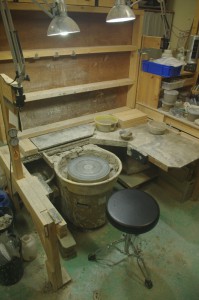
陶芸に使う道具は割り箸など身近なもので工夫して作ることも。わかりやすいよう、よく使うものには何用か明記している。

田代さんの仕上げは電気ロクロではなく手回しロクロで行うのも特徴。「元々今成先生がやっていた仕上げ方です。電気ロクロではないので時間はかかります。けど、その分機械で均一に仕上げた質感ではなく、少しいびつな土のあたたかみが残ります。」と田代さん。
— 昔から器用でしたか?
子供の頃から手先は器用でした。プラモデルもすごくこだわって作っていました。
— 作っている最中は無心ですか?
ロクロをひくときは集中したいですね。他の作家さんとも話題になったことがありますが、話しながら出来る人とそうでない人と分かれるみたいです。僕は出来ない人ですね。でも仕上げは話しながらでも大丈夫です
— 作業中は音楽などかけますか?
最近は上原ひろみやケイコ・リーなど、ジャズが好きです。あとはラジオ。
昔からオーディオが好きだったので仕事場の音響にもこだわりたいと思っていました。
— やっている作業によって音楽のジャンルはかえますか?
僕はゆったり派です。ずっと工房で作業をしているので、激しい音楽は少し疲れてしまいます。
— 陶芸以外には何か好きなことはありますか?
出かけたりもしますが、基本的にはずっと陶芸のことを考えているタイプですね。
― 例えば今度はこういうことを試してみよう、とかも考えていたりしますか?
そうですね。出てきたイメージを試してみたいと思うことはたくさんあります。ただ必ずしも、そのイメージした通りにならないのがこの仕事です。なので実際にやってみないとわかりません。
— 目の前にその結果が出るまでの時間が、陶芸の場合は長いですよね?
そうですね、うちの窯は大体月に1回焼く程度なんです。だから1回作ってみても、さらに改良しテストするにはまた1ヶ月先まで結果が分らない、ということになります。
— メモやノートをとっていたりするのですか?
あまり細かなことはつけてないですが、アイデアや、本当に大切だと思うことはつけています。また、実験は必ずノートにつけています。土や泥、釉薬のレシピなど全部書き残しています。定番として正規に使う物と、実験とでノートを分けています。
— 器は化学反応ですから無限にその組み合わせがあると思うのですが?
基本を決めておかないと、調合やその濃さ、何に対してどう使うのか、全部試したりやり過ぎたりすると泥沼にはまってしまって、通常の仕事ができなくなる恐れがあります。ついつい突き詰めたくなってしまう方なので、できるだけ必要なことだけをやるようにしています。
— よくうつわは使ってみないいとわからないといいますが、田代さんご自身はお料理されますか?またそれで変えてみるということもありますか?
レパートリーは少ないですが料理はします。実際に盛り付けて、使ってみて感じる事は多いです。もちろん、それで仕様を変更する事もあります。手で持った時の感触や口当りは、表面に施す釉薬や焼き方などでも変わってきます。焼締の場合は仕上げに使うヘラなども関係してきますし、焼きあがった後にペーパーで磨いたりもしています。
—田代さんの作品は薄いフォルムのものが多いですが、こういったシンプルな形にはどうやっていきついたのでしょうか?
元々シンプルなものが好きでした。薄作りなのはロクロを挽く時の自分の手のクセみたいなもので、それに合わせ仕上げも行うので自然とそうなりました。それから、これまで様々なテストをしてきましたが、その中で思い通りになったものもあれば、その倍以上に失敗がありました。けど、それがイメージ通りになっていなくても、その物の別の良さに気付ける自分の目を養うことも必要だと、ある時から感じるようになりました。その様にして出てきた様々な副産物も今の自分の器の姿に役立っています。そうやってずっと模索しながらやってきましたし、この仕事を続ける限りこれから先も研究しながらの作業になるのだと思います。その中でシンプルな形でも表情豊かな器を作りたいと思っています。
<取材を終えて>
私は料理をする際、作る前に献立と一緒にうつわも考えるのだが、順番としては献立が先のことが多い。だが田代さんのうつわは、うつわを使いたくて、今の季節なら何が合うだろう?とうつわに合わせて献立を考える。
想像することが楽しくなる、ワクワクする、自由を感じるうつわだ。
そして陶器市や個展などで見かけるたびに、新鮮な発見があり、今度はどう使おうかと高揚感が沸いてくる。
繊細な作りだけれど土のあたたかみを感じる。今回の取材を通し、あらためて田代さんのうつわに対するひたむきな情熱が伝わってきた。とにかく、手に取って、使っていただきたいと思う器である。
================================
<作家プロフィール>
1979年 宮崎に生まれる
2002年 奈良芸術短期大学陶芸専攻科卒業
2002年 今成誠一氏に師事
2007年 益子にて独立

